- Details
- Hits: 1089
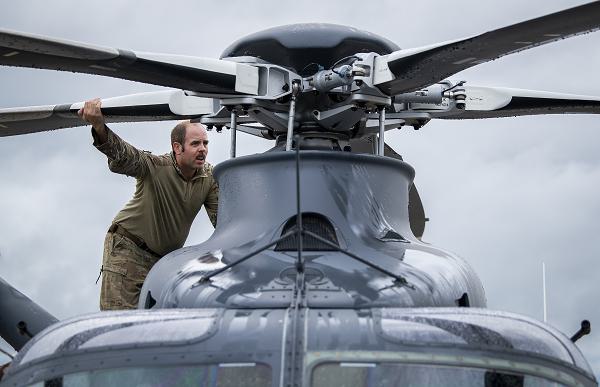
Eglin Air Force Base, Florida. (July 11, 2024): America has a new chopper to patrol intercontinental ballistic missile fields, the Grey Wolf. In this photo by Samuel King Jr., Jake Marsh with the 96th Operations Group performs a preflight check on the new MH-139A Grey Wolf’s rotors after one of its last test flights. The Grey Wolf underwent four years of developmental testing by the 413th Flight Test Squadron and is now being delivered to nuclear bases at Malmstrom AFB, Montana, F.E. Warren AFB, Wyoming, and Minot AFB, North Dakota.
The Grey Wolf replaces the UH-1N Huey that entered service in 1970. The new chopper is a joint venture between Boeing and Leonardo Aerospace and is a militarized version of the civilian AW139 helicopter that can fly faster, higher, farther, and with more weight than the aging Huey. The civilian version is currently used for VIP/corporate transport, offshore transport, firefighting, law enforcement, and search and rescue. The Air Force says the Grey Wolf can cruise fifty percent faster and farther than the Huey with a larger cabin and the ability to lift an additional five thousand pounds.
The military version is a dual-piloted, twin-engine helicopter that integrates military communication, navigation, transponder, and survivability enhancements. Key features include cockpit and cabin armor, self-sealing crashworthy fuel cells, a countermeasures dispenser set, and two externally mounted M240 machine guns. It can fly three hours, or 225 nautical miles, without refueling and is designed to carry nine combat equipped troops and their equipment.
The 96th Test Wing is the evaluation center for air-delivered weapons, navigation, guidance, and command and control systems for the Air Force.
- Details
- Hits: 994
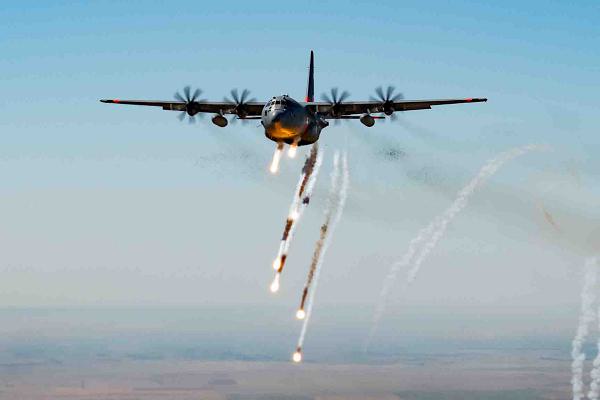
Fort Carson, Colorado. (July 9, 2024): Every military aircraft carries precious cargo, from billions in equipment to the irreplaceable lives of our servicemembers. Protecting America’s ability to safely transport troops and equipment is the Air Force’s top priority. In this photo Technical Sergeant Justin Norton, a C-130H Hercules belonging to the 302nd Airlift Wing expends chaff and flares during a training sortie as a part of Exercise Ivy Mass 2024. Most American combat aircraft have countermeasures to protect the crew from ground fire and heat-seeking or radar guided missiles. The main three categories of countermeasures are Infrared, Electronic, and Chaff.
Infrared Countermeasures are designed to protect aircraft from heat homing missiles by confusing the missiles' infrared guidance system so that they miss their target. These measures include firing flares which create multiple “fake” targets for the incoming missile. Heat-seeking missiles were responsible for about 80% of air losses in Operation Desert Storm during the first Gulf War.
Electronic countermeasures involve protecting communication networks from interception and jamming by enemy forces. Used offensively, these electronic devices are designed to trick or deceive radar, sonar, or other detection systems. They are also used to disrupt enemy communications to create a fog of confusion to break up coordinated attacks. The system may make many separate targets appear to the enemy, or make the real target appear to disappear or move about randomly. This is especially helpful when dodging missiles.
- Details
- Hits: 1312
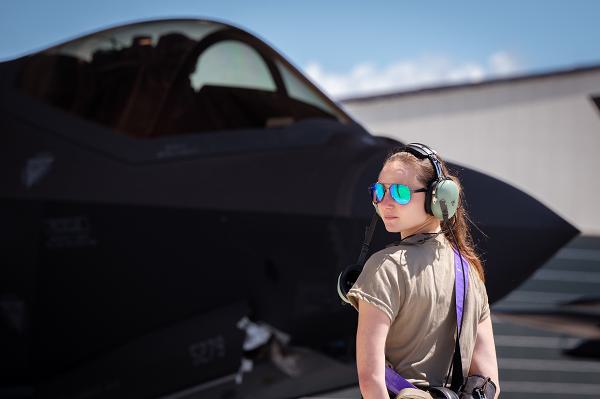
South Burlington, Vermont. (July 10, 2024): Pilots may get all the glory, but they depend on one person to ensure they keep flying, their Crew Chief. In this photo by Technical Sergeant Richard Mekkri, Senior Airman Alexandra Banke, a Crew Chief with the 158th Fighter Wing of the Vermont Air National Guard, guides an F-35A Lightning II into position for takeoff. As Crew Chief, Airman Banke is responsible for ensuring her aircraft is properly maintained and ready to fly.
Each aircraft is assigned a chief who oversees all aspects of maintenance, repairs, and inspections before a pilot can take flight. They watch over technicians performing daily maintenance, replacing parts, and keeping the proper records. They also conduct inspections of the aircraft to identify malfunctions or to spot trouble before it becomes mission threatening. They travel with their aircraft to inspect and service it before flight and then reinspect, refuel, and repair the craft on landing.
Beyond these basic duties, Crew Chiefs also play a role in the event of a crash, helping with the rescue and giving emergency medical care. They typically supervise a team of five highly trained specialists while assisting in the removal of engines, transmissions, and rotor blades. They function as mentors by ensuring all safety rules are followed and that Airmen comply with Air Force security standards.
To become a Crew Chief, a candidate must complete basic training at Lackland Air Force Base followed by 46 to 109 days of advanced training depending upon the aircraft they are assigned. This is followed up by several months of on-the-job training before they are assigned their very own bird.
- Details
- Hits: 964

Okinawa, Japan. (July 5, 2024): A recent public opinion survey of Europeans who recently visited the U.S. remarked that “Americans seem to hang their flag everywhere.” That is true, we hang old glory from flag poles, mailboxes, cars, and even our clothing. In this photo by Sgt. 1st Class Henry Gundacker, one Soldier found yet another unique place to display his patriotism. Pictured are (from left to right) Maj. Robert S. Bourgeau, Sgt. 1st Class Corey O. Tomasich, Capt. Erik McDowell and Capt. Timothy Robinson showing the colors while conducting an underwater reenlistment ceremony. SFC Tomasich, an underwater demolition specialist, chose his workplace to take the oath and asked his comrades to go below to stage the event.
Some particularly gung-ho Soldiers compete to stage the most unique ceremonies to renew their commitment to serve, from hanging off a cliff while rappelling to taking the pledge mid-air during a free fall jump. Tomasich’s wife Anita and his children Maycee, Ellie and Tripp stayed topside for the ceremony but are nevertheless proud of their adventurous Dad.
Tomasich is with the 10th Support Group which is responsible for Army logistical support for units throughout the Pacific. He has served tours in Germany, South Korea, and Japan and is about to apply for Officer’s Candidate School.
Support Our Troops congratulates Tomasich and his family and wish them god speed in their future challenges.
- Details
- Hits: 1061
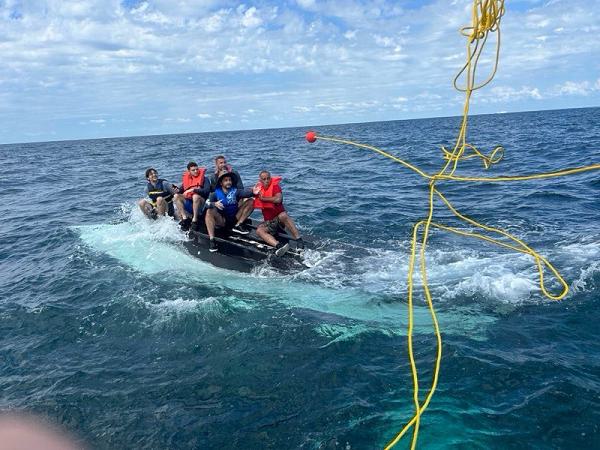
Jacksonville, Florida. (July 12, 2024): The U.S. Coast Guard rescued five people after their 24-foot vessel capsized eleven miles off Florida’s coast and the unlucky sailors are fortunate to be alive. In the above photo, Coast Guard personnel throw a lifeline to the stranded mariners who were desperately clinging to their overturned craft.
Coast Guard Sector Jacksonville command center received a 911 relay from the Jacksonville Sheriff’s Office that a boat was in distress far offshore and needed immediate rescue. Coast Guard Station Mayport dispatched a boat crew and Guard Air Station Savannah sent a helicopter crew to assist. The stranded crew were located eleven miles offshore wearing life vests which provided time for authorities to mount a rescue. They would likely not have survived without them.
The boat crew was transported to the Mayport Boat Ramp where family members were anxiously waiting. All five were medically evaluated and were in good shape after their ordeal. The overturned boat was left adrift in the ocean and the owner must arrange for its salvage.
Coast Guard officials reminded mariners to post a float plan and to always ensure there are life vests for everyone on the boat.
- Details
- Hits: 1140
“I don’t have a fear of heights. I do, however, have a fear of falling from heights.”
Comedian George Carlin
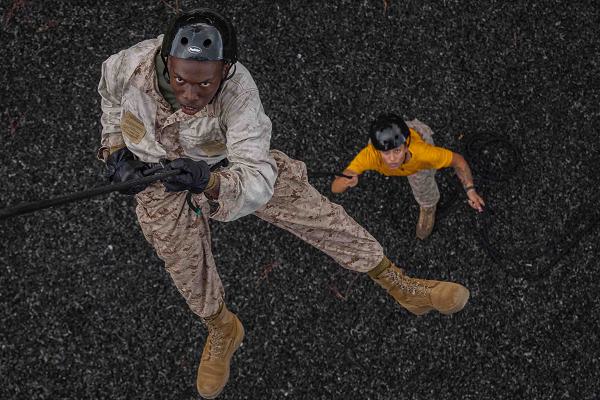
Marine Corps Recruit Depot Parris Island, South Carolina. (July 1, 2024): Acrophobia, or simply a fear of heights, is a form of anxiety disorder that causes an irrational sense of doom when one encounters high places for some people. In this photo by Lance Corporal Ayden Cassano, Marine Corps Recruit Jhevon Smith descends a 47-foot rappel tower with a look of both terror and determination on his face.
While a certain amount of fear around heights can be expected, such as the uneasy feeling one gets standing on a bridge or looking down from a tall building. This is normal as most people experience a certain amount of anxiousness around heights. But people with acrophobia experience intense and unreasonable fear when they’re faced with heights, including everyday tasks such as climbing a flight of stairs, standing near a balcony, or parking a car in a multiple-floor parking garage. Sufferers experience rapid heartbeat, dizziness, shortness of breath and a queasy feeling when encountering high places to the extent they can be life limiting.
The military teaches recruits to overcome these fears, and in the bargain, they gain confidence in the equipment and training. That is why rappelling is taught in Basic Training to instill just such confidence.


